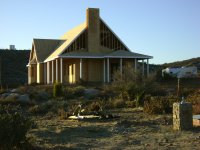Yeah, the can-light problem is a lesson learned the hard way. 115 cans can't be all wrong

.
When I build in 2006, all this was not quite well known. I'm very glad I put sconces in the halls and up high in the TV room for low background lighting (use 7W CFLS equivalent to 25W incandescence). I've had to replace the kitchen 23W CFLs with 60W incandescents. If you look at the base of a CFL in can use, they go from white to dark yellow in a hurry. I've left in the 13W bulbs, pulled all the 23W and replaced with incandescent. Some measurements put the exterior of the base at 160 F, making the interior up in the 190 to 200F range. I also used the $18 a pop shiny reflecting air tight trim kits, which make things much worse. Small volume and no air flow. In the closets and showers, I used the bathroom trim kits which are just a plastic lens flush fit against the drywall. The 13W and 23W bulbs do OK since there is more air space in the can and a few slots and holes to help ventilate. But with no reflection (the can is aluminum, but it doesn't reflect like the shiny trim kits) I had to go to a 23W bulb to get the same light as a 13W in a reflective kit. So that's 50W of impact on the power plant vs. a 60W incandescent bulb. Works economically for me because I'm paying for 23 watts of power. Bases are not too discolored so I should get some nice long life out of them and the associated economic benefits including recouping the higher bulb costs.
In my work room, I changed the cans that are on all day long by putting in one of those extenders that creates 2 outlets where you screw in the bulb. This makes the bulb stick out of the fixture a bit and helps with the temperature (i have a temp probe I used to check this out). The aesthetics police wound't like this arrangement, but it works. Only to be use in shop like environments where you are stuck with can lights.
Two more lighting related ideas that are good and score high on the spousal approval system: In the bedrooms, I put the digital dimers on one can over the bed, with a switch as you enter the room and a switch you can reach from the bed. These are stock big box store Lutron dimmers. You have a good reading light, you can enter the room and then turn off the light from the bed, and when you have to get up in the middle of the night you don't have to go from groggy to 6 suns of brightness. These dimmers also ramp up the intensity, so the bulb life should be fantastic.
The 2nd thing I did was put outlets in halls so that I could put in the outlets that have a built in LED night light (also a box store item you can get). CdS photocell turns them off in the day. Also have 2 in the bathroom (they will work on a GFI circuit) and that's all you need there in the night. It looks odd to see outlets in the hall, but it's a big win.
I also put "12V" (really 13.8 battery voltage) LED emergency lights in, the lights are home brew. The main room also has LED up lighting. Cool effect, not cheap, home-brew board for that too. All that is controlled by the automation system.
saltman: Like most florescence, CFLs are kinda like well pumps. Run forever but only start so many times. So for short term use the economic benefit is lower. Where they shine (so the speak) is the hall or kitchen light you leave on all night, and this is where the sconce with a vertical bulb, open at the top, ventilation holes in the bottom is great. Note you can start with CFLs and transition to incandescence as they fail. You may find that some last longer than you'd expect and opt to keep with the CFL.
Also, not all brands are alike. I wish I had bought all Sylvania, GE or Phillips brand, not the unknown big box store brands. The flood light CFLs, if they are in an open fixture where it's just the socket with no "hood" over the bulb, are OK for outdoor use since the base and electronics is siting in the open air all the time. I've had problems when they were on a pole in the open due to water getting into the plastic dome over the "spring bulb", but they've been good where they are protected under an overhang. Note also that all my exterior flood lights on the house are right next to a window so they can be changed without a ladder. I'm not getting any younger....
Pete

